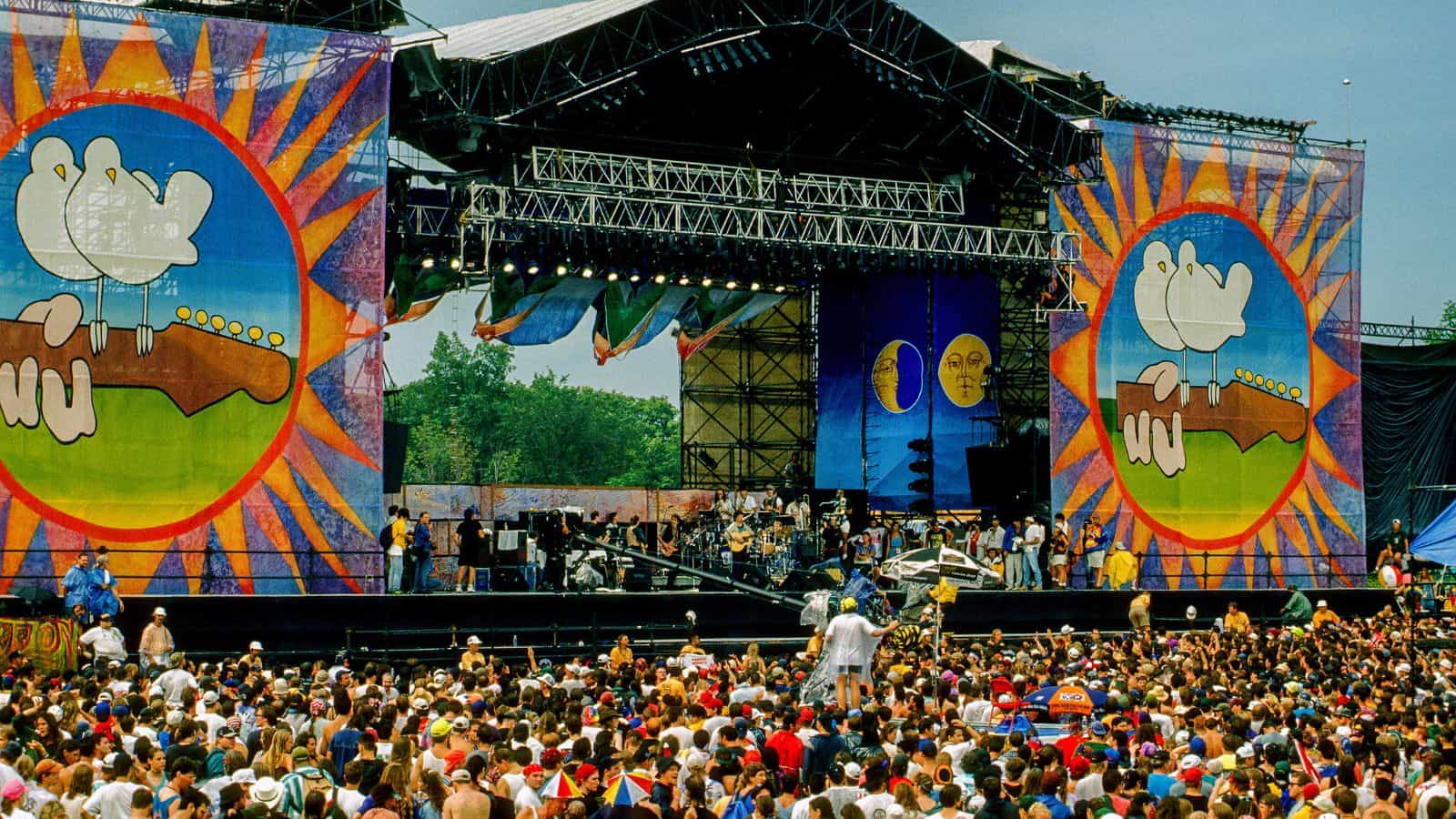With its beginnings in the early 1960s, the counterculture movement saw young people across the world advocating for peace and love. Influencing music, art, and fashion, hippies stood against the conservative social norms of the generations before them. Do you remember any of these 17 things done in the 1960s and 1970s? It’s possible you were a hippie!
Attended Woodstock Music Festival

With music, art, and a peaceful ethos, Woodstock symbolized the pinnacle of hippie culture, attracting hundreds of thousands of festival-goers. Musical performances such as Jimi Hendrix and The Who became legendary and have influenced music and culture in the decades since.
Lived in a Commune

According to The Guardian, “In the late 1960s and early 1970s, there was a vogue for communal living. It was a lifestyle that distilled hippie values, combining personal freedom and a desire to break with convention.” Embracing communal living meant engaging in collective farming, shared meals, and communal decision-making.
Wore Bell-Bottom Jeans

In a time of rebellion, bell-bottom jeans were a strong statement against the conservative clothing styles of previous generations and symbolized freedom from societal norms. Hippies combined the jeans with tie-dye shirts, peasant blouses, and leather-fringed vests to create a distinctive style.
Advocated for Peace and Love

Hippies stood for peace and love during a time of turbulent politics and often participated in peaceful protests and sit-ins against the Vietnam War. Peace and love were central to the hippie philosophy and influenced music, art, literature, and daily interactions within the community.
Practiced Meditation and Yoga

Hippies integrated yoga and meditation into their daily lives as tools for self-exploration, mental clarity, and physical well-being. Time Magazine says the benefits of meditation were widely studied at this time, and one study “found that people meditating used 17% less oxygen, lowered heart rates, and produced increased brain waves that could help with sleep.”
Experimented with Psychedelic Drugs

Psychedelic drugs shaped the aesthetics, music, and philosophies of the hippie movement and were used as a means of personal and spiritual discovery in social settings or as part of artistic experiences. The drugs were illegal and not approved of by wider society, creating challenges for those wanting to use them.
Protested Nuclear Weapons

Engaging in creative and non-violent forms of protesting, hippies used music, art, and theatrical elements to stand against the use of nuclear weapons. The global movement reflected the hippie commitment to peace and the belief in the power of collective action to bring about change.
Traveled in VW Buses

An icon of hippie culture, the VW bus symbolized freedom, adventure, and rejection of conventional values. Smithsonian Magazine says, “Its boxy appearance—unlike anything the major auto manufacturers in Detroit were producing—became a symbol for counterculture types who wanted to stand out from the rest of the crowd.”
Listened to Psychedelic Rock

The psychedelic rock genre epitomized the hippie movement’s love of music, using experimental sounds, innovative recording techniques, and lyrical themes of peace, love, and exploration. Live performances were also often accompanied by light shows and other forms of visual experiences.
Participated in Environmental Movements

Hippie communities were early to engage with environmental activism, and they advocated for the protection of natural resources, opposition to pollution, and the promotion of sustainable living practices. This reflected the hippie ethos of living in harmony with nature and helped inspire future generations.
Attended the Summer of Love

In 1967, thousands of hippies flocked to the Haight-Ashbury district of San Francisco to participate in a summer-long celebration of music, art, and free expression. The Guardian says, “Young people traveled from across America and beyond, attracted by the promise of the chance to cast off conservative social values and experiment with drugs and sex.”
Practiced Free Love

The concept of free love challenged traditional norms around relationships and sexuality, instead advocating for sexual freedom, openness, and experimentation as forms of personal and social liberation. This influenced society, allowing for changing perceptions of love, sex, and relationships and contributing to the broader sexual revolution of the ’60s and ’70s.
Created Psychedelic Art

Psychedelic art used bold colors, intricate patterns, and symbolic imagery to capture the vibrant, transcendent, and often surreal experiences associated with the hippie movement. It allowed the expression of inner experiences and had a significant influence on poster art, album covers, and fashion.
Wore Psychedelic and Tie-Dye Clothing

Embracing psychedelic art and using fashion as an expression of individuality, tie-dye became synonymous with the hippie movement of the 1960s and 1970s. According to Vox, “Performers like Janis Joplin, John Sebastian, and Joe Cocker wore tie-dye onstage at Woodstock in 1969, cementing it as a key look at the iconic music festival.”
Followed a Vegetarian or Vegan Diet

The popularity of vegetarian and vegan diets within hippie cultures reflected the values of compassion, non-violence, and environmentalism. This influenced the food manufacturing industry, popularizing natural and organic foods and contributing to the growth of health food stores.
Engaged in Civil Rights Activism

Valuing social justice, hippies participated in civil rights activism in the fight against racial discrimination, segregation, and injustice in marginalized communities. Collaborating with diverse groups and individuals, hippies participated in marches, rallies, and acts of civil disobedience.
Explored Alternative Religions and Spirituality

Spirituality was a big part of hippie culture, and they engaged with a variety of practices and beliefs outside of mainstream Western religion. Eastern philosophies heavily featured in and helped to shape the identity and ethos of the hippie movement, influencing values, lifestyles, and communal practices.
Read More: 21 Things That Will Be Lost Forever When The Boomer Generation is Gone

Baby boomers grew up in a vastly different culture, so they have what younger generations consider strange habits. An internet survey recently asked, “What will die with boomers?” Here are the top 22 answers.
21 Things That Will Be Lost Forever When The Boomer Generation is Gone
18 Common Phrases That Signals Support for Trump

Understanding the unique language of politics, particularly among Trump supporters, can provide valuable insights into the nation’s current state. Here’s a deeper look into 17 phrases you’ll likely only hear from this demographic.
18 Common Phrases That Signals Support for Trump
17 Religious Facts People Get Wrong All the Time

Religious beliefs and practices are often misunderstood, leading to common misconceptions. Some are just too general, others are downright out there. So, we’ll be correcting 17 widely circulated ‘facts’ about world religions.
17 Religious Facts People Get Wrong All the Time
Why People Aren’t Religious Anymore: 15 Simple Reasons

As society evolves, so does our approach to spirituality. This article looks at the subtle yet profound shift from traditional religious adherence to a more personal, evidence-based belief system.
Why People Aren’t Religious Anymore: 15 Simple Reasons
17 American Attractions That Not Even Americans Want to Visit

The United States of America—land of the free, home of the brave, and the location of some of the most ‘unique’ tourist attractions you’ll ever lay eyes on.
Get ready to chuckle, scratch your head, and maybe even facepalm as we look at 17 American attractions that not even Americans think are worth visiting.
17 American Attractions That Not Even Americans Want to Visit

